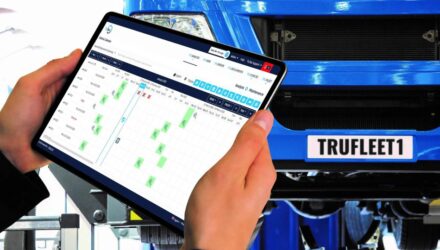With technology developing at an ever increasing rate, along with the legal demands and responsibilities on fleet and transport managers, Steve Thomas, Managing Director, Inseego UK Ltd discusses in the following article, the role that new AI tools can help manage these demands.
Telematics is ultimately about altering behaviour, but this has been the responsibility of the fleet manager to use performance data to directly engage with the driver. Historically, the telematics system has provided the tools for the fleet manager to engage and manage drivers, but all too often the amount of data being generated becomes overwhelming. Many simply do not have the time or resources to use the available information and convert it into actionable insight, so AI tools and processes could offer much needed support to overstretched fleet professionals.
One of the biggest issues we see from a fleet manager’s perspective is the amount of data they must contend with daily from multiple systems and hardware. Fleet management teams have been under pressure for some time, and with operational efficiencies and business performance prioritised, there is a risk that road safety gets overlooked.
AI can increasingly be used to interrogate a wide range of data and video sources – behaviour, incidents, near misses, fuel usage, speed limits, location, weather conditions – to create a holistic view of driver performance. This AI-powered analysis will enable the telematics system to understand where issues exist and take the appropriate steps to resolve these exceptions.
By combining multiple data sets, that would be impossible to analyse manually, a fleet manager can create a true picture of fleet risk and pinpoint driver behaviour that requires attention. Someone speeding, in the rain, outside a school is clearly a higher risk than someone marginally over the speed limit in dry conditions on a motorway, but most current systems would not differentiate, making it harder to prioritise intervention.
Vehicle cameras, for example, typically upload video clips based on g-force events, but often these are triggered by false positive events such as harsh driving, potholes and speed humps. For a fleet of 50 vehicles, if each generates four clips per day, the fleet manager would have 1,000 videos to watch a week, which is simply not workable. This is not just about having the time to view footage, but also being able to react quickly to situations that need immediate attention, both from a Duty of Care and insurance perspective.
With post event machine vision, the video telematics software can view the video clips and flags up those that need attention. This means a fleet manager can quickly focus on actual collisions or an incident where a vulnerable road user (pedestrian, motorcyclist or cyclist) was involved. The AI technology of this kind has already been shown to reduce the number of clips needing review by as much as 99% leaving just a handful that can be checked in a matter of minutes.
Meanwhile, driver communication and management will increasingly be influenced by AI with greater levels of automation as a result. This is happening to a certain extent, but we will see the technology rapidly evolve to the point where the telematics system will possess the ability to communicate with the drivers directly, which will massively reduce the burden on the fleet manager.
There are already active examples around driver behaviour monitoring and education, with some exciting developments in targeted training that provides engagement and coaching, triggered by specific recurring behaviour. The ability to create bespoke programs – with automated safety messages, performance reports and training modules – can address individual issues, change driver attitudes, and mitigate fleet risk.
Moving forward, we will start seeing the technology handle many aspects of fleet management including training, compliance, vehicle usage, and working hours to take on much of the hard work. Many driver, vehicle and fleet processes will soon move from human intervention to automatic system management, leaving the fleet manager to deal with the 2-3% that truly requires their attention. For the rest, they will be able to oversee using reporting dashboards that intelligently measure ongoing performance.
There will be of course those – both drivers and fleet managers – that view AI with suspicion, fearing excessive Big Brother or seeing it as a threat to their role. There have been similar concerns about other fleet systems, such as vehicle tracking and video telematics, but the adoption of these technologies is increasingly widespread and accepted. This will be much the same for AI as greater understanding of its value and potential becomes clear.
AI will make it much easier in the future to spot and correct the most serious issues within a fleet operation. As such, it has a growing role to play within the fleet sector, as well as underpinning telematics innovation, with the potential to transform how critical data is analysed and how drivers are managed.
Author: Steve Thomas, Managing Director, Inseego UK Ltd



















